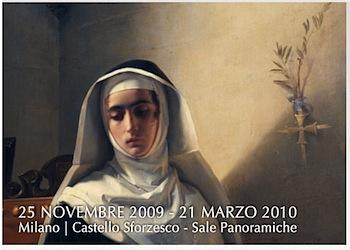If you are in or near Milan between now and next Sunday you have a chance to catch the last few days of an unusual exhibition at the Castello Sforzesco: in an attempt to understand the lives of women forced into convents in the sixteenth and seventeenth centuries, the life of the Monaca di Monza or Nun of Monza has been reconstructed by means of family documents and some of the Nun’s letters, lent by the Ambrosiana Library.
Marianna De Leyva was born into a noble Spanish family in Monza in 1575. Less than a year after her birth, her mother, Virginia Maria Marino, died of plague, leaving her considerable fortune equally to Marianna and her half-brother, the child of Virginia Maria’s first marriage. This caused legal wrangles in the family and Marianna was sent to the Convent of Santa Margherita in Monza at the age of 16, probably in an attempt to disinherit her.
At the Convent Marianna took the name of suor Maria Virginia but she was also known there as “La Signora”.
She was desperately unhappy and in letters she begged her father to allow her to return home but he would not change his mind. Later she began an affair with a nobleman called Gian Paolo Osio, who lived in a neighbouring property. Marianna subsequently had two pregnancies, giving birth to a stillborn son in 1598 and a daughter, Francesca, in 1604. Osio gave Francesca a home.
However, another nun, suor Caterina, threatened to expose the relationship and Osio killed her. Marianna and her confidantes, suor Ottavia and suor Benedetta, helped him to hide the body. He then killed suor Ottavia, fearing that she would talk, but suor Benedetta escaped and Osio was arrested. Osio was sentenced to death and Marianna to life imprisonment in a walled-in cell.
She was released after thirteen years on the orders of Cardinal Federico Borromeo, with whom she had corresponded.
Marianna owes her fame mainly to Manzoni, who portrays her as suor Gertrude in “I Promessi Sposi” [The Betrothed] and takes the action forward to 1628 – 30. In the novel her lover is called Egidio.









